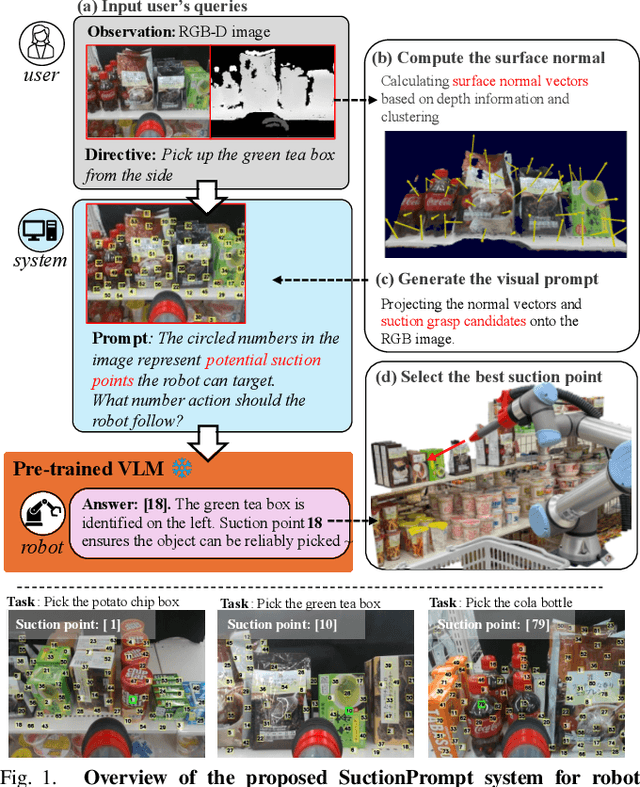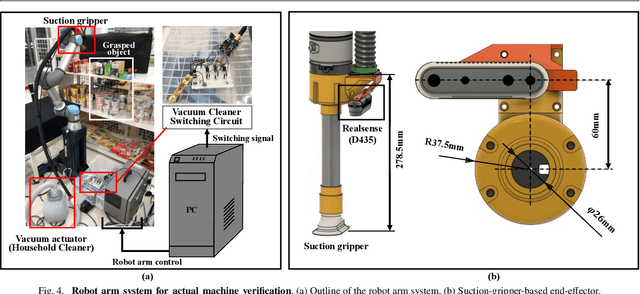Ryo Hanai
Learning Bimanual Manipulation via Action Chunking and Inter-Arm Coordination with Transformers
Mar 18, 2025Abstract:Robots that can operate autonomously in a human living environment are necessary to have the ability to handle various tasks flexibly. One crucial element is coordinated bimanual movements that enable functions that are difficult to perform with one hand alone. In recent years, learning-based models that focus on the possibilities of bimanual movements have been proposed. However, the high degree of freedom of the robot makes it challenging to reason about control, and the left and right robot arms need to adjust their actions depending on the situation, making it difficult to realize more dexterous tasks. To address the issue, we focus on coordination and efficiency between both arms, particularly for synchronized actions. Therefore, we propose a novel imitation learning architecture that predicts cooperative actions. We differentiate the architecture for both arms and add an intermediate encoder layer, Inter-Arm Coordinated transformer Encoder (IACE), that facilitates synchronization and temporal alignment to ensure smooth and coordinated actions. To verify the effectiveness of our architectures, we perform distinctive bimanual tasks. The experimental results showed that our model demonstrated a high success rate for comparison and suggested a suitable architecture for the policy learning of bimanual manipulation.
Attention-Guided Integration of CLIP and SAM for Precise Object Masking in Robotic Manipulation
Feb 26, 2025Abstract:This paper introduces a novel pipeline to enhance the precision of object masking for robotic manipulation within the specific domain of masking products in convenience stores. The approach integrates two advanced AI models, CLIP and SAM, focusing on their synergistic combination and the effective use of multimodal data (image and text). Emphasis is placed on utilizing gradient-based attention mechanisms and customized datasets to fine-tune performance. While CLIP, SAM, and Grad- CAM are established components, their integration within this structured pipeline represents a significant contribution to the field. The resulting segmented masks, generated through this combined approach, can be effectively utilized as inputs for robotic systems, enabling more precise and adaptive object manipulation in the context of convenience store products.
SuctionPrompt: Visual-assisted Robotic Picking with a Suction Cup Using Vision-Language Models and Facile Hardware Design
Oct 31, 2024



Abstract:The development of large language models and vision-language models (VLMs) has resulted in the increasing use of robotic systems in various fields. However, the effective integration of these models into real-world robotic tasks is a key challenge. We developed a versatile robotic system called SuctionPrompt that utilizes prompting techniques of VLMs combined with 3D detections to perform product-picking tasks in diverse and dynamic environments. Our method highlights the importance of integrating 3D spatial information with adaptive action planning to enable robots to approach and manipulate objects in novel environments. In the validation experiments, the system accurately selected suction points 75.4%, and achieved a 65.0% success rate in picking common items. This study highlights the effectiveness of VLMs in robotic manipulation tasks, even with simple 3D processing.
Visual Imitation Learning of Non-Prehensile Manipulation Tasks with Dynamics-Supervised Models
Oct 25, 2024Abstract:Unlike quasi-static robotic manipulation tasks like pick-and-place, dynamic tasks such as non-prehensile manipulation pose greater challenges, especially for vision-based control. Successful control requires the extraction of features relevant to the target task. In visual imitation learning settings, these features can be learnt by backpropagating the policy loss through the vision backbone. Yet, this approach tends to learn task-specific features with limited generalizability. Alternatively, learning world models can realize more generalizable vision backbones. Utilizing the learnt features, task-specific policies are subsequently trained. Commonly, these models are trained solely to predict the next RGB state from the current state and action taken. But only-RGB prediction might not fully-capture the task-relevant dynamics. In this work, we hypothesize that direct supervision of target dynamic states (Dynamics Mapping) can learn better dynamics-informed world models. Beside the next RGB reconstruction, the world model is also trained to directly predict position, velocity, and acceleration of environment rigid bodies. To verify our hypothesis, we designed a non-prehensile 2D environment tailored to two tasks: "Balance-Reaching" and "Bin-Dropping". When trained on the first task, dynamics mapping enhanced the task performance under different training configurations (Decoupled, Joint, End-to-End) and policy architectures (Feedforward, Recurrent). Notably, its most significant impact was for world model pretraining boosting the success rate from 21% to 85%. Although frozen dynamics-informed world models could generalize well to a task with in-domain dynamics, but poorly to a one with out-of-domain dynamics.
NeuralLabeling: A versatile toolset for labeling vision datasets using Neural Radiance Fields
Sep 21, 2023



Abstract:We present NeuralLabeling, a labeling approach and toolset for annotating a scene using either bounding boxes or meshes and generating segmentation masks, affordance maps, 2D bounding boxes, 3D bounding boxes, 6DOF object poses, depth maps and object meshes. NeuralLabeling uses Neural Radiance Fields (NeRF) as renderer, allowing labeling to be performed using 3D spatial tools while incorporating geometric clues such as occlusions, relying only on images captured from multiple viewpoints as input. To demonstrate the applicability of NeuralLabeling to a practical problem in robotics, we added ground truth depth maps to 30000 frames of transparent object RGB and noisy depth maps of glasses placed in a dishwasher captured using an RGBD sensor, yielding the Dishwasher30k dataset. We show that training a simple deep neural network with supervision using the annotated depth maps yields a higher reconstruction performance than training with the previously applied weakly supervised approach.
Force Map: Learning to Predict Contact Force Distribution from Vision
Apr 12, 2023



Abstract:When humans see a scene, they can roughly imagine the forces applied to objects based on their experience and use them to handle the objects properly. This paper considers transferring this "force-visualization" ability to robots. We hypothesize that a rough force distribution (named "force map") can be utilized for object manipulation strategies even if accurate force estimation is impossible. Based on this hypothesis, we propose a training method to predict the force map from vision. To investigate this hypothesis, we generated scenes where objects were stacked in bulk through simulation and trained a model to predict the contact force from a single image. We further applied domain randomization to make the trained model function on real images. The experimental results showed that the model trained using only synthetic images could predict approximate patterns representing the contact areas of the objects even for real images. Then, we designed a simple algorithm to plan a lifting direction using the predicted force distribution. We confirmed that using the predicted force distribution contributes to finding natural lifting directions for typical real-world scenes. Furthermore, the evaluation through simulations showed that the disturbance caused to surrounding objects was reduced by 26 % (translation displacement) and by 39 % (angular displacement) for scenes where objects were overlapping.
 Add to Chrome
Add to Chrome Add to Firefox
Add to Firefox Add to Edge
Add to Edge